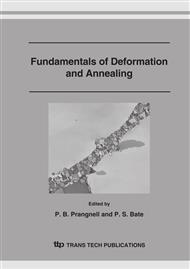p.399
p.405
p.411
p.417
p.423
p.429
p.435
p.441
p.447
Microstructural Refinement during Annealing of Plastically Deformed Austenitic Stainless Steels
Abstract:
The phenomena of strain hardening, strain induced martensite formation, recovery, martensite reversion and recrystallization have been studied in austenitic stainless steels of the AISI 304L and 316L types, after solution annealing, followed by rolling at different temperatures (-196, 25, 100 and 200°C) and subsequent annealing of the worked samples. Strain hardening and the percentage of α’ martensite formed showed strong dependency with the deformation temperature and with the austenite chemical composition. As expected, both strain hardening as well as the amount of the martensite formed was higher in the 304L steel and for lower temperatures. Reversion temperature of the α’ martensite was close to 550°C for both steels, independent of the amount of martensite. The 316L steel presented a higher resistance to recrystallization when compared to the 304L steel. The recrystallization temperature of both steels was about 150°C higher than the α’ phase reversion temperature. Rolling temperature did not influence significantly the recrystallization temperature. Proper thermal and mechanical treatments lead to interesting combinations of mechanical properties in both steels with values such as yield strength YS of about 1000 MPa, with an elongation around 10%.
Info:
Periodical:
Pages:
423-428
Citation:
Online since:
July 2007
Authors:
Price:
Сopyright:
© 2007 Trans Tech Publications Ltd. All Rights Reserved
Share:
Citation:


